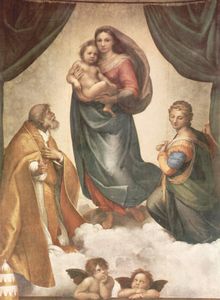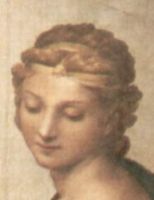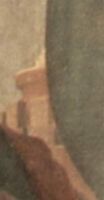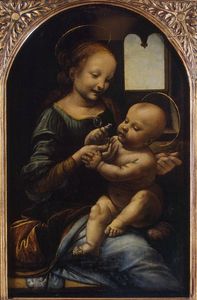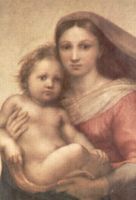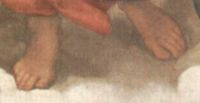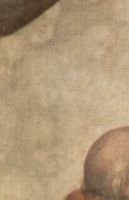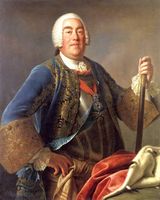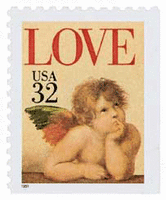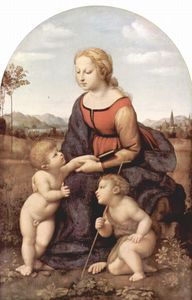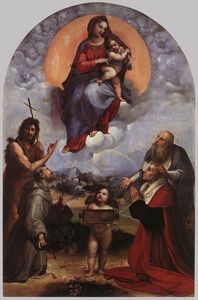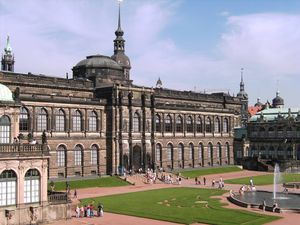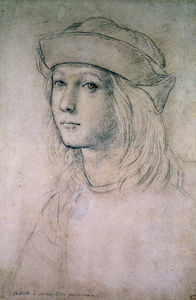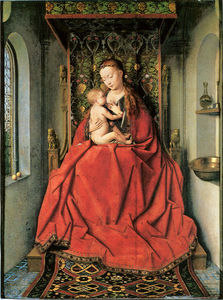Sistine Madonna
- Date of Creation:
- 1514
- Height (cm):
- 265.00
- Length (cm):
- 196.00
- Medium:
- Oil
- Support:
- Wood
- Subject:
- Figure
- Framed:
- No
- Art Movement:
- Renaissance
- Created by:
- Current Location:
- Dresden, Germany
- Displayed at:
- Gemäldegalerie Alte Meister
Sistine Madonna Story / Theme
Commissioned by Pope Julius II in 1513, The Sistine Madonna is one of the world's most recognizable paintings. Capturing the public's imagination ever since its creation, the two cherubs at the bottom of the altarpiece who sit as observers looking up at the Madonna and the Christ child as they descend from a heavenly space.
Aside from the two cherubs, there are four other heavenly beings within Raphael's large alter painting. On the viewer's left, there is Martyr Pope Sixtus II. He looks up at the Holy Mother and child and points out to an invisible audience as if to say, "look at those who come to pay worship to you and the Holy child", his hand has the appearance of almost reaching out of the frame of the painting.
Looking closely at the pope's right hand, one can see that it appears that he has five fingers and a thumb. The reason behind this phenomenon remains unknown and the existence (planned or unplanned) is a matter of contestation. Pope Sixtus's Pope Miter rests down below next to where the cherubs sit - it has probably been removed to pay respect to the Holy Mother.
On the Madonna and baby Jesus' right side is the patron saint of artillery gunners, lighting and all those who risk their lives in working - Saint Barbara. Unlike the cherubs and Pope Sixtus II, she is not looking at the Holy Mother but down at the cherubs. This enigmatic look has been difficult for art scholars over centuries to comprehend; it consists of an overall tone of sadness but with a hint of a smile. Hidden in the background behind a curtain near Saint Barbara is a tower which is a representation of her imprisonment (in a tower) as she was locked away for her belief in Christianity in opposition to her father.
This painting was said to have been painted for the Epiphany, which usually includes the three kings of the East but instead we see Mary and Christ hovering on clouds. Wearing her traditional red and blue, Mary holds the Christ child as she looks out to the invisible audience, which Pope Sixtus II is pointing out towards. The mother and child have their heads touching as they look out on this crowd with Mary holding Christ snuggled against her and wrapped in the veil of her layered dress. Their faces show no expression (or at least any discernable expression) as they look out and lock eyes with the viewer. The Holy Mother, Christ Child, Pope Sixtus II, and Saint Barbara each have halos over their heads but which are barely visible because of years of fading.
The Sistine Madonna is painted with the illusion of being on a stage. This stage appears visible from the plank that the cherubs rest on and the curtain and rod that frame the painting. The curtains are open for the display of the Holy Mother and the Christ Child for the audience as Pope Sixtus II presents the Madonna to all who have come to see her.
Sistine Madonna Inspirations for the Work
Raphael had already executed a series of brilliant Madonna paintings in Florence between 1505 and 1507, La Belle Jardiniere (please see Related Paintings below) being but one example. These works are all marked especially by the influence of Leonardo da Vinci, who had been making great innovations in painting since the 1480s.
Raphael was called to Rome at the end of 1508 by Pope Julius II, on whom he had made a great impression. The Sistine Madonna was commissioned as an altarpiece for the chapel of the convent of St. Sixtus in Piacenza in 1513. Pope Julius II had a particular interest in the St. Sixtus chapel, given that before becoming Pope (then still a Cardinal) he had made a contribution to the original building fund for the chapel, which housed the supposed relics of St. Sixtus and St. Barbara.
Sistine Madonna Analysis
Mystery solved:
Only recently have some of the questions surrounding the Sistine Madonna and the expressions of the Madonna and baby Christ finally been resolved. Recent research by A. Prager suggests the key to the mystery lies in the position in which the altarpiece originally stood. In examining what Pope Sixtus II is pointing at and what the Mother and Child are looking at, Prager argues that opposite to the altarpiece in S. Sisto and above the rood screen at the far end of the chancel there stood a crucifix. The expressions of horror on the faces of Mother and Child are thus their reaction to the sight of death.
-

Sistine Madonna
-

Sistine Madonna
-

Sistine Madonna
Composition:
There are a host of art historians who have attempted and failed to adequately explain Raphael's Sistine Madonna, particularly the expressions on the faces of the Madonna and Child. Despite this, the Sistine Madonna is said to be a painting depicting the Epiphany (although the traditional Epiphany contains three kings).
Madonna and Christ are shown to be hovering in the clouds; the young mother looks innocent and is clasping baby Jesus in her scarf to her breast. She is wearing the famous impenetrable gaze as her right cheek touches baby Jesus' head and she floats barefoot with toes that are too short and unnatural.
In a break from the Madonna's Raphael painted in Florence, her dress is thin with her nipple clearly visible. The color of mother and son's hair, eyes and skin are similar, but the faces do not contain any similarity. The baby Christ child is bending his right leg and resting his left hand below his knee on the shin.
In the painting Pope Sixtus II takes his pope's miter off and puts it on the plank where the two cherubs are resting on their arms. He is staring at Madonna and Christ in surprise.
The two cherubs are the most popular image associated with the Sistine Madonna given the huge amount of merchandise (gift cards etc. ) that is sold regarding the painting in Dresden (where the painting is located) and around the world. One of the cherubs is resting his chin on his left hand and the other is folding his arms. Both of them are looking up to Madonna and her son as onlookers.
The Sistine Madonna's background is also extremely difficult to analyze. It has been suggested that the background represents ghost like baby images represent either angels or unborn children. The babies' faces are expressionless and their pupils are not visible which gives the unsettling image of lifelessness.
Raphael's Sistine Madonna makes heavy use of reds, greens and whites. These are the traditional colors of Italy. In addition, Raphael has painted the Mary in her traditional blue and red, along with Pope Sixtus II in gold and white, the official colors of the Pope and Holy Church. Despite this, these colors do not overawe the central figures of the painting, the Madonna and Christ child.
Use of light:
By the time Raphael painted the Sistine Madonna he was an expert in the use of Chiaroscuro, which he adapted from his mentor da Vinci. In the painting there are strong contrasts between light and dark, and he achieves an elegant sense of volume (as in all his paintings) in the human body shapes.
Mood, tone and emotion:
Raphael's Sistine Madonna is regarded as a defining piece of classic art from the High Renaissance. It gives a highly idealized depiction of the forms represented, achieved simultaneously with his characteristic sprezzatura. Raphael's work has a calm and extroverted tone which explains its longevity as a popular, universally accessible form of visual communication.
Brush stroke:
Raphael's Sistine Madonna painting has a seemingly effortless grace, which belies the careful planning and attention to detail involved in its creation. This work is another demonstration of his superb draftsmanship, his ability to control line with complete assurance and mastery. At the time of completing the Sistine Madonna drawing was considered a superior skill to the handling of color, the argument being that line was a more intellectual discipline and color essentially decorative.
Sistine Madonna Critical Reception
The esteem in which the Sistine Madonna was held after its creation can be seen by the lengths that Dresden went to acquire it in the mid-18th century. During Raphael's lifetime the piece was regarded as another example of his genius.
Such was the renown of the Sistine Madonna that Augustus III, the Elector of Saxony and the King of Poland wanted to obtain the artwork for Saxony. At the beginning of the year 1752, the court of Saxony began to negotiate with the monks of the St. Sixtus (who were under financial difficulties) to purchase the picture. The court said the value was 15,000 scudi, and finally an agreement was reached and the picture was sold to the court of Saxony for the price of 25,000 scudi in the year 1754.
Even to this day such an exorbitant amount of money has never been paid for a picture. The price of 25,000 scudi was said to have been enough to build a whole district of a town in that era.
Even today the Sistine Madonna remains a symbol of Dresden and everywhere you go in that city it can be found. The two cherubs at the foot of the painting and the figure of Saint Barbara have often been used and reproduced in popular culture, such as stamps, gifts and Christmas cards.
Generations of visitors to the Gemäldegalerie in Dresden have been deeply impressed by the way in which Raphael portrayed the Madonna in this painting and it has been reproduced over and over again.
Sistine Madonna Related Paintings
Sistine Madonna Locations Through Time - Notable Sales
The Sistine Madonna was probably originally intended to decorate the tomb of Pope Julius II. It was for some time located in the convent of Saint Sixtus in Piacenza and was later sold (as described) by the monks to Augustus III of Saxony. The painting's most recent history during and following the Second World War is very interesting.
During the hostilities, Adolf Hitler had the Sistine Madonna locked in the museum's vault, which meant the painting survived allied bombings. After the Second World War it was brought to Moscow where Stalin vaulted it. It was returned to Dresden in the 1950s. It remains in the Gemäldegalerie in Dresden.
Sistine Madonna Artist
In many ways The Sistine Madonna was a return to a subject Raphael knew inside out. It is a theme he either had great affection for or belief in its subject matter for building artistic technique because it is the most recurrent theme throughout his career, particularly during his time in Florence. He was, by the time of the Sistine Madonna's painting, probably the most famous artist in the whole of Europe and any inhibitions (if indeed he ever felt any in his art) would have well and truly vanished.
Sistine Madonna Art Period
Sistine Madonna is possibly the most famous artwork, by the most famous artist of the most famous art periods in history. Painted after the works of the Stanza della Segnatura it is the culmination of balance and quality that characterized the High Renaissance.
Whilst Raphael would paint other works after the Sistine Madonna, he would move on to other art forms (for example architecture) and increasingly have his workshop involved in more collaborative pieces before his death. Because Raphael's death signaled the end of the High Renaissance art period this work is all the more important.
Sistine Madonna Bibliography
There are countless books written about Raphael and the High Renaissance. Below is a selection of recommended reading on the artist and his works.
• Brown, Clare & Evans, Mark. Raphael: Cartoons and Tapestries for the Sistine Chapel. V & A Publishing 2010
• Chapman, Hugo, et al. Raphael: From Urbino to Rome. National Gallery Company Ltd, 2008
• De Vecchi, Pier Luigi. Raphael. Abbeville Press Inc. , 2003
• Jones, R. Raphael. Yale University Press, 1987
• Talvacchia, Bette. Raphael. Phaidon Press Ltd, 2007
• Whistler, Catherine. Michelangelo and Raphael Drawings. Ashmolean Museum, 1990

